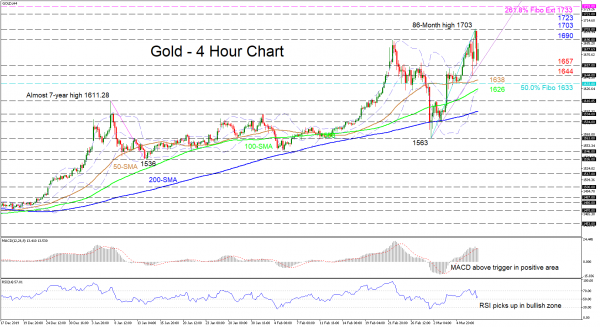Gold’s pullback from a multi-year high of 1,703 found support at the mid-Bollinger band around 1657 and the very short-term supportive trendline pulled from February 28.
The short-term oscillators suggest positive momentum is picking up, with the RSI improving ahead of its 50 mark and the MACD holding just at its red trigger line in the positive zone.
If the yellow metal sustains its position above the supportive trendline and the mid-Bollinger band, initial resistance could come from 1,690 ahead of the upper Bollinger band slightly overhead. If buyers persist and surpass the fresh peak of 1,703, the commodity could rally towards the 1,723 high from back in December of 2012. Pushing over this too, the 1,733 level – which is the 261.8% Fibonacci extension of the down leg from 1,611.28 to 1,536 – could be next to challenge buyers’ efforts.
Otherwise, if sellers drive below the 1,657 barrier and the ascending trendline, the next support could come at the swing low of 1,644. Conquering this, the key area of the 50-period simple moving average (SMA) at 1,638 and the 1,633 level – which is the 50.0% Fibonacci retracement of the up move from 1,563 to 1,703 – could prevent the price from reaching the 100-period SMA at 1,626 and the nearby lower Bollinger band.
Summarizing, the near-term picture of the precious metal continues to appear positive, with higher highs and lows formed above the trendline and the bullish sentiment in the SMAs.














